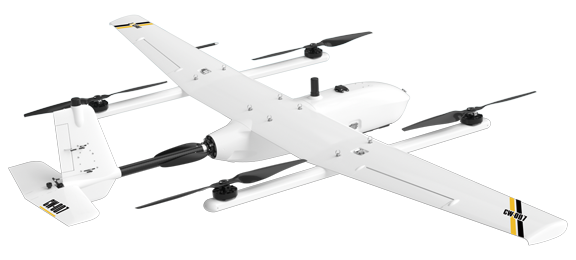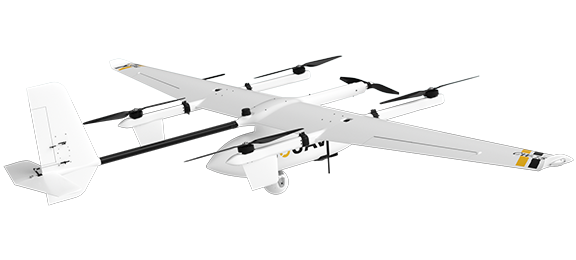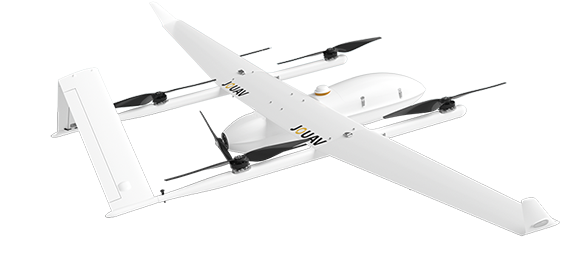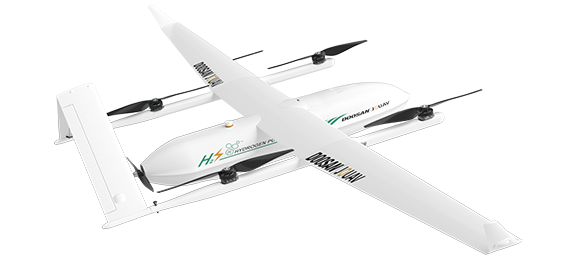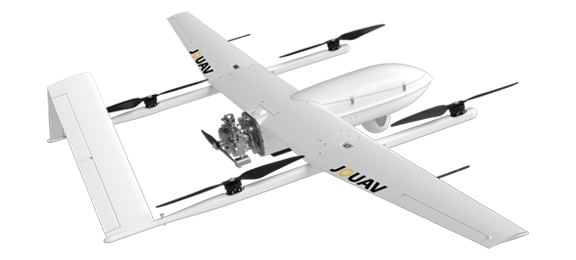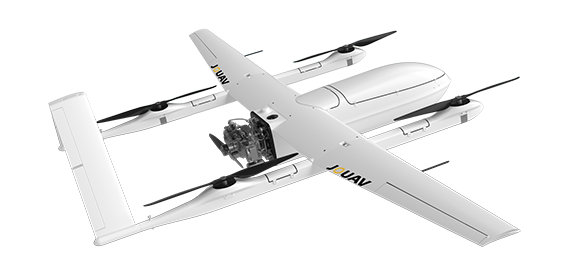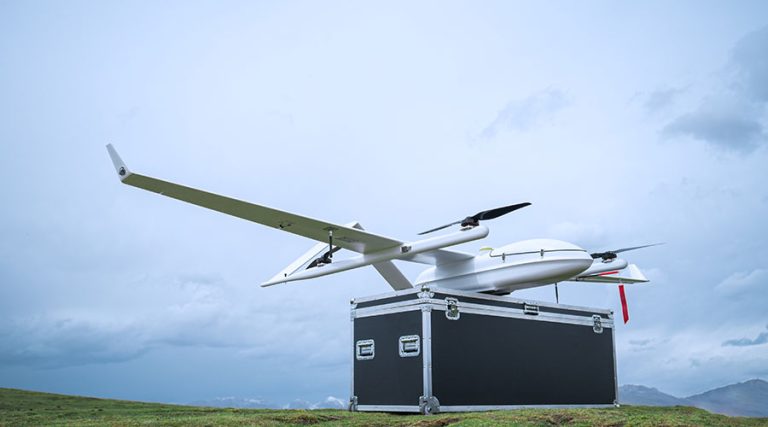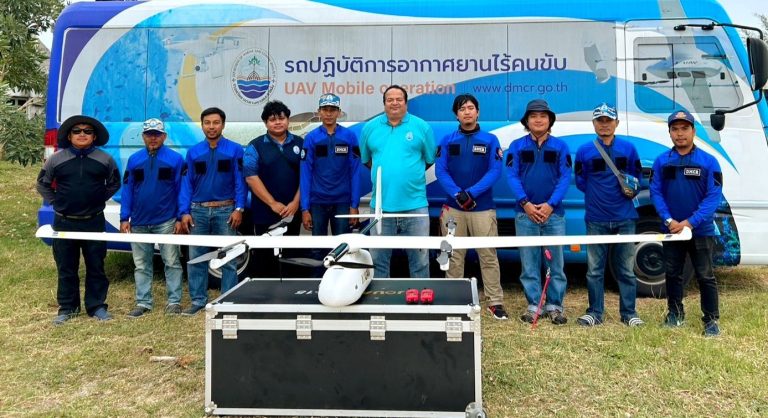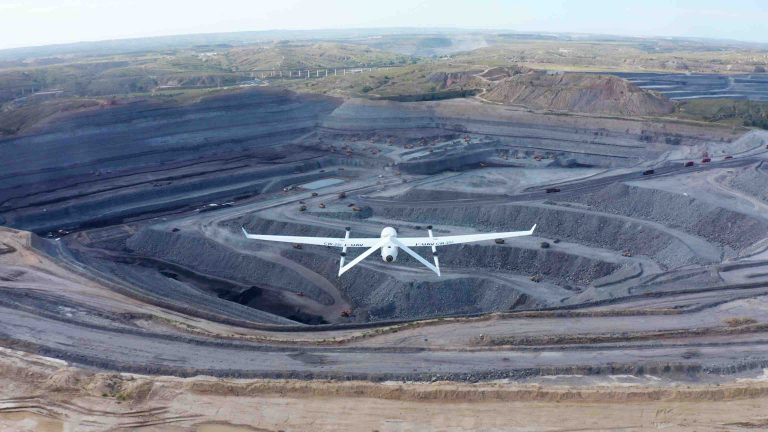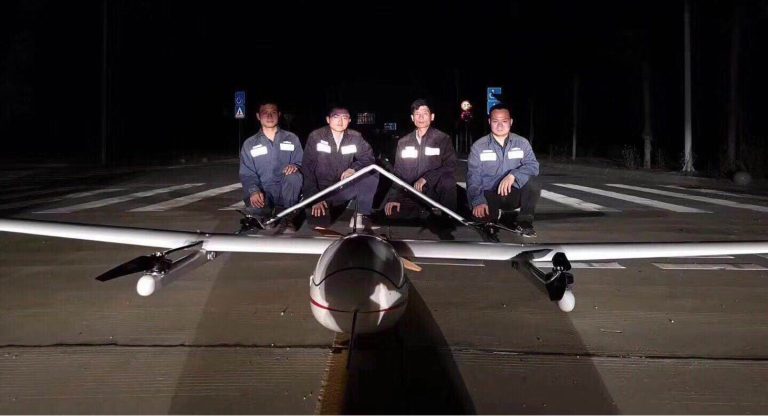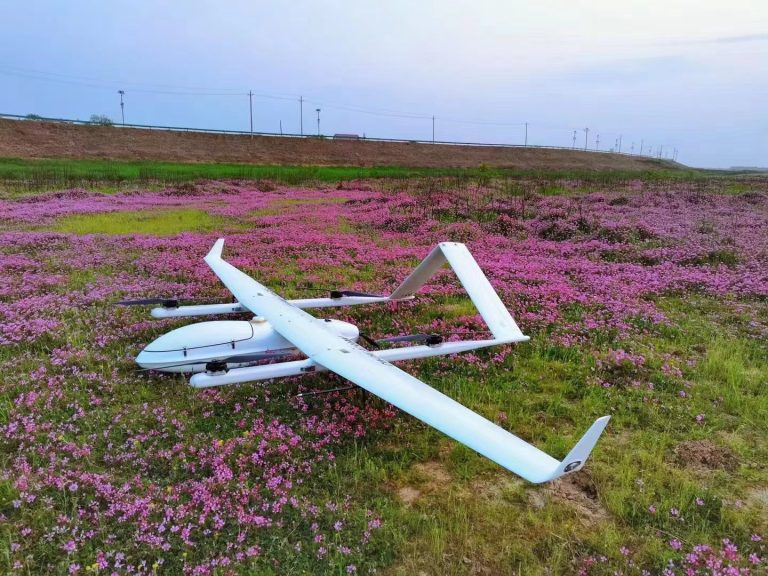A fixed-wing drone is an unmanned aerial vehicle (UAV) that uses fixed wings, similar to those of an airplane, to generate lift. Unlike rotary-wing drones, such as quadcopters that use rotating propellers for lift and maneuverability, fixed-wing drones rely on their aerodynamic wings to stay aloft.
These drones typically feature a rigid wing structure, a propulsion system (usually a motor-driven propeller or jet engine), and onboard avionics for navigation and control. Fixed-wing drones are known for their ability to cover long distances, sustain extended flight times, and carry heavier payloads.

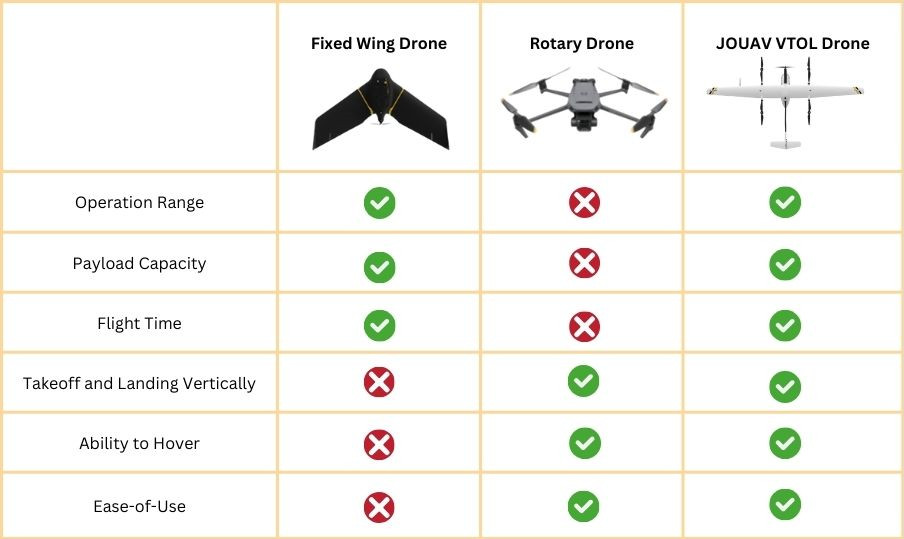
Fixed-wing drones require a runway or launcher for takeoff and land with gear or a parachute. Rotary UAVs, with multiple rotors, can take off and land vertically (VTOL), hover, and maneuver in tight spaces. JOUAV VTOL fixed wing drones combine the advantages of both, offering vertical takeoff and landing with efficient fixed-wing cruising.
Fixed-wing drones excel in long missions like mapping and surveying due to their aerodynamic design. Rotary drones, though highly maneuverable, have shorter flight times, making them ideal for close-up inspections and real-time monitoring. JOUAV hybrid drones balance between the two, offering extended flight times by switching to fixed-wing mode for cruising.
Fixed-wing drones, being larger and more efficient, can carry heavier payloads such as advanced sensors, high-resolution cameras, and LiDAR systems. Rotary UAVs, being smaller, are limited to lighter cameras and sensors. JOUAV VTOL drones offer variable payload capacities, often comparable to fixed-wing drones, due to their larger size and fixed-wing capabilities.
Fixed-wing drones require more expertise for takeoff, landing, and long-range navigation. Rotary UAVs are easier to fly, need less space, and suit a wider range of pilot skill levels. VTOL fixed-wing drones, while easier to fly than fixed-wing drones due to their VTOL capabilities, may require more experience when flown in fixed-wing mode compared to basic rotary drones.
Fixed-wing drones offer excellent range and flight time but require large spaces for landing. Multi-rotor UAVs can take off and land vertically but sacrifice range and flight time. The JOUAV VTOL fixed wing UAVs combines the long range, extended flight time, and large payload capacity of fixed-wing drones with the vertical takeoff and landing capabilities of multi-rotor drones.
Takeoff and Landing Anywhere
JOUAV hybrid drones can take off and land almost anywhere, including confined spaces, rough terrain, moving ships, and cars. This flexibility eliminates the need for large runways or soft landing areas required by fixed-wing drones.
Extended Coverage
With up to 480 minutes of flight time, a range of 200 km, and a flight speed of 100 km/h, JOUAV drones can cover significantly more ground, up to 6 times faster than standard fixed-wing drones. This makes them ideal for extensive surveying and mapping missions.

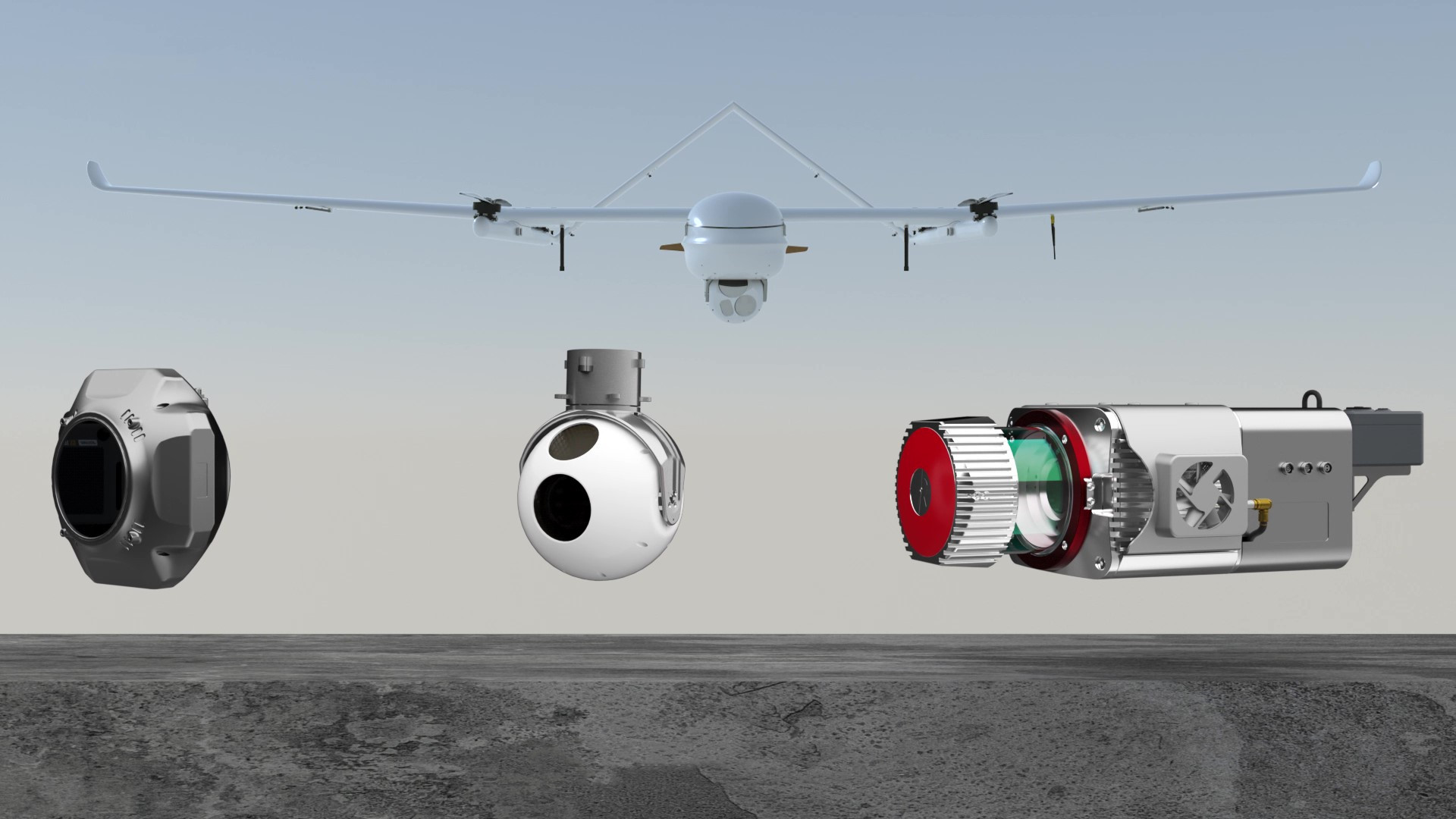
Versatile Payload Integration
JOUAV drones support a payload capacity of up to 20 kg and feature an open system architecture, allowing integration with various payloads such as aerial cameras, LiDAR sensors, gimbal cameras, miniSAR, and more. This versatility makes them perfect for applications like mapping, surveillance, and inspection.
Effortless Operation and Enhanced Safety
No complex piloting or training is required. Simply set your mission, and the JOUAV drone takes care of the rest, navigating with precision and efficiency. Advanced sensors (GPS, IMU, etc.) enable real-time awareness and autonomous decision-making for safe, reliable flight.
Due to their ease of control, take-off and landing ability, and high flight efficiency, JOUAV CW Series drones expand and enhance the applications of UAVs. Explore VTOL UAV solutions for your industry.
Surveillance and Security
JOUAV fixed wing drones autonomously patrol vast areas with advanced cameras and analytics. They deliver real-time video feeds and trigger intruder alerts, significantly boosting border security, perimeter monitoring, and safety at large events.
Emergency Response
JOUAV's VTOL design enables rapid deployment for search and rescue in disaster zones, avalanches, or any hard-to-reach area. Long-range flights cover vast areas, while thermal cameras aid searches in low-light conditions.
Aerial Surveying and Mapping
JOUAV drones capture incredibly detailed imagery (GSD 5-8mm/pixel) and achieve exceptional accuracy (1cm horizontal), ideal for high-resolution topographic maps and precise land surveys.
Infrastructure Inspection
JOUAV's VTOL design and high-tech payloads (cameras/LiDAR) enable detailed inspections of infrastructure like power lines, pipelines, and wind turbines, even in hard-to-reach areas.
Mining Operation
JOUAV drones capture high-resolution images of mining blasts, enabling precise analysis of blast patterns and fragmentation for future optimization. This reduces the need for personnel in hazardous areas.
Precision Agriculture
JOUAV drones equipped with multispectral cameras can capture data on vegetation health indices like NDVI. This allows farmers to identify areas with nutrient deficiencies, potential diseases, or irrigation needs.
Many companies in different industries have already benefited from the use of JOUAV drones. Discover how JOUAV solutions are used around the world.
Choosing the right fixed-wing UAV can be a daunting task, given the variety of options available in the market. To ensure you make an informed decision, it is essential to consider several key factors that align with your specific needs and requirements.
Purpose and Application
The first step is to clearly define the purpose of your fixed-wing drone. Here are some common applications:
- Security and Surveillance: Cover large search areas efficiently with drones boasting exceptional flight times and potentially thermal imaging capabilities.
- Mapping and Surveying: Create detailed topographical maps or precisely survey large fields for agricultural purposes. Focus on drones with long flight times and high-resolution camera capabilities.
- Inspection and Monitoring: Conduct routine inspections of pipelines, power lines, or wind turbines. Look for drones with extended range and the ability to carry specialized inspection payloads.
- Precision Agriculture: Invest in drones with payload capacity for specialized sensors to monitor crop health. Consider features like variable-rate application for targeted delivery of fertilizers or pesticides.
Flight Range and Endurance
A fixed-wing drone's flight range and endurance are crucial for maximizing its efficiency and productivity. A long-range drone allows you to cover more extensive areas without interruptions, while increased endurance ensures longer data collection or exploration sessions. This is particularly beneficial for aerial photographers, surveyors, and mappers who need to cover vast territories or conduct prolonged missions.
Prioritize fixed-wing drones with a flight range of at least 10 kilometers and an endurance of 1 hour or more to get the most out of your aerial operations.
Payload Capacity and Versatility
The payload capacity of a fixed-wing drone determines its adaptability to different tasks and industries. A drone with suitable payload capacity ensures you can integrate the necessary sensors and cameras without compromising flight performance.
Opt for fixed-wing drones with payload capacities ranging from 1 to 5 kilograms (2.2 to 11 lbs) to accommodate a wide range of sensors, cameras, and other payloads required for your specific tasks.
Autonomous Features
Automation is a game-changer in the world of fixed-wing drones, simplifying operations and enhancing flight precision. An autonomous drone with advanced features like GPS-based waypoint navigation, follow-me mode, and return-to-home functions not only makes flight planning more straightforward but also adds an extra layer of safety to your missions.
Choose fixed-wing drones equipped with comprehensive autonomous features to streamline your flights and ensure a secure experience.
Hybrid VTOL Capabilities
For those who require the flexibility of vertical take-offs and landings, fixed-wing drones with hybrid VTOL capabilities are the ideal solution. These drones combine the advantages of both fixed-wing and multirotor UAVs, making them versatile for various missions, especially in confined spaces.
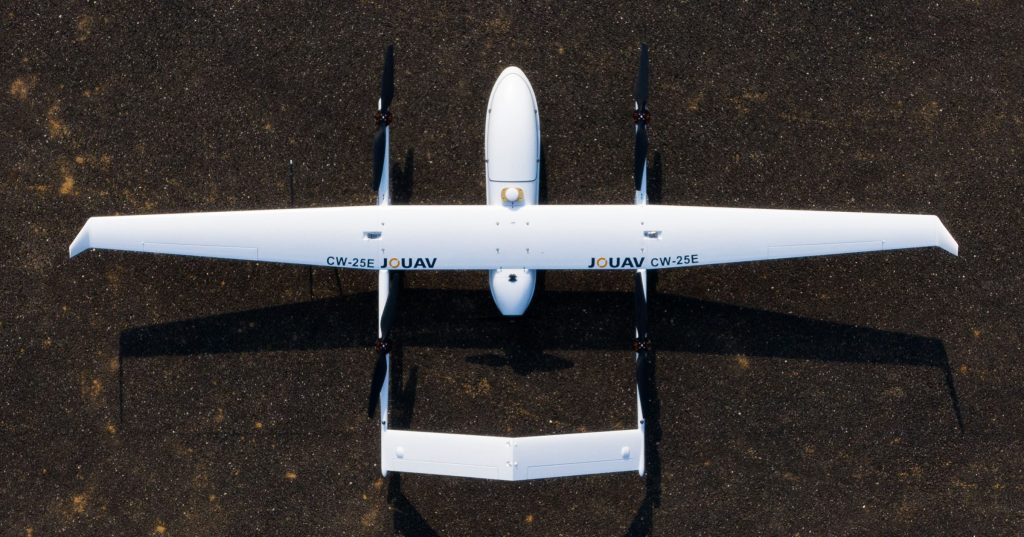
What is the Range of a Fixed Wing Drone?
The range of a fixed-wing drone can vary significantly depending on factors such as its design, size, payload, battery capacity, and operating conditions. Here's a general range:
- Hobbyist Fixed-Wing Drones: These typically have a range of 5-25 kilometers (3-15 miles).
- Commercial Fixed-Wing Drones: These can reach ranges of 50-150 kilometers (30-90 miles) depending on the factors mentioned above.
- Long-Range Fixed-Wing Drones: These are specially designed for extended missions and can achieve ranges exceeding 200 kilometers (120 miles).
How Long Can Fixed Wing Drone Fly?
Fixed-wing drones fly significantly longer than multi-rotor drones, lasting from 1 hour to over 8 hours on a single charge. Their flight time depends on battery capacity, payload weight, and wind conditions.
How Fast Does the Average Fixed-Wing Drone Go?
The average fixed-wing drone's speed varies based on its purpose and design:
- Consumer models: Designed for recreation or basic photography, they fly at 25-50 kilometers per hour (15-31 miles per hour).
- Commercial models: Used for mapping, surveying, or inspections, they reach speeds of 70-100 kilometers per hour (43-62 miles per hour).
- High-performance models: For racing or research, these can exceed 160 kilometers per hour (100 miles per hour), with some reaching nearly 300 kilometers per hour (186 miles per hour).
How Much Does a Fixed Wing UAV Weight?
The weight of a fixed-wing UAV can vary significantly depending on its purpose, size, and configuration. However, here is a rough data range to give you an idea:
- Small fixed-wing UAVs: 2 to 5 kilograms (4.4 to 11 pounds)
- Medium-sized fixed-wing UAVs: 5 to 25 kilograms (11 to 55 pounds)
- Large fixed-wing UAVs: 25 to 150 kilograms (55 to 330 pounds)
Are Fixed Wing Drones Suitable for Indoor Use?
Fixed-wing drones are generally not suitable for indoor use due to their need for a runway or open space for takeoff and landing. Their design requires a forward motion to generate lift, which makes them more suitable for outdoor applications with ample airspace.
Are Fixed Wing Drones Suitable for Beginners?
While fixed-wing drones can be more challenging to fly compared to their multirotor counterparts, they are still suitable for beginners. Starting with a smaller, entry-level fixed-wing drone and receiving proper training and guidance can help beginners learn to fly and gain proficiency.
How Hard Is It to Fly a Fixed Wing Drone?
Flying a fixed-wing drone requires some knowledge and experience, as they typically require manual takeoff and landing and rely on control inputs for maneuvering. However, with proper training and practice, flying a fixed-wing drone can become relatively straightforward.
Can Fixed Wing Drones Hover Like Multirotor Drones?
Fixed-wing drones are not designed to hover like multirotor drones. They require constant forward motion to maintain lift and control. However, some advanced fixed-wing drones may have built-in stabilization systems that allow them to fly in relatively tight circles or perform specific maneuvers.
How Much Does a Fixed Wing Cost?
The cost of fixed-wing drones can range anywhere from around $200 to several thousand dollars, depending on the specifications and features of the drone. The cost for entry-level fixed-wing drones typically falls in the range of $200 to $1,000. These drones are usually more affordable, suitable for beginners, and come with basic features and capabilities.
The cost for high-end professional-grade fixed-wing drones can vary significantly, ranging from around $50,000 to $200,000 or more. These drones are designed for advanced users and professionals, offering advanced features, longer flight times, higher-quality cameras, and more precise control.
Feel free to contact JOUAV. What we can help you:
